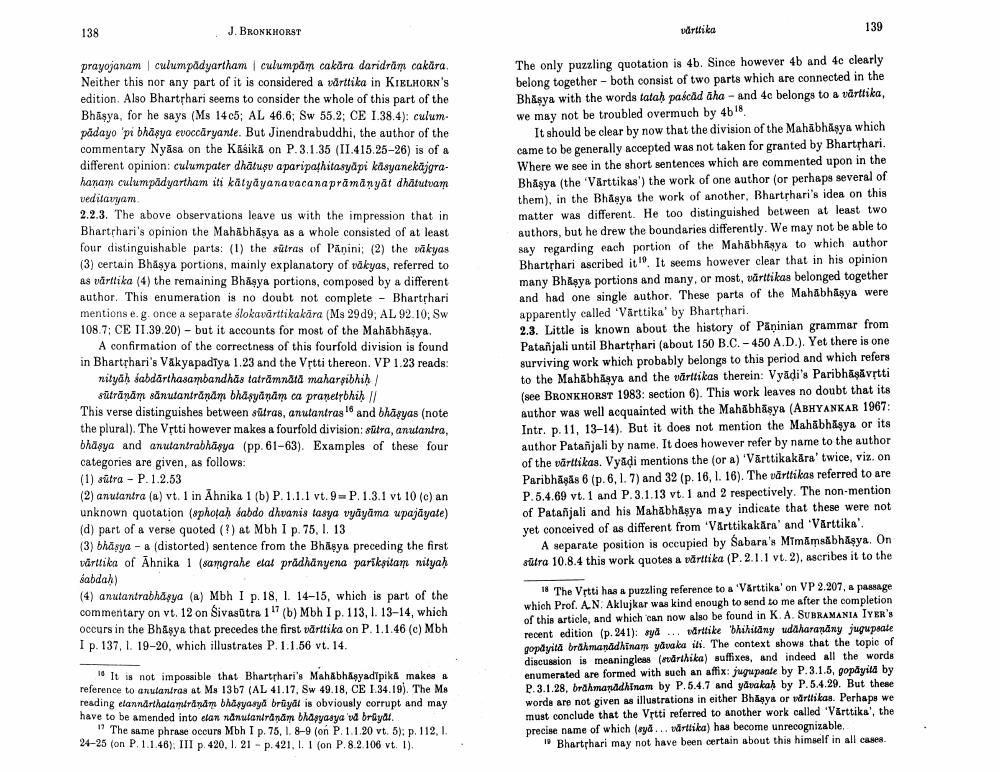Book Title: Archiv Fur Indische Philosophie Author(s): Johannes Bronkhorst Publisher: Johannes Bronkhorst View full book textPage 9
________________ 138 J. BRONKHORST prayojanam | culumpadyartham | culumpam cakāra daridram cakāra. Neither this nor any part of it is considered a varttika in KIELHORN'S edition. Also Bhartṛhari seems to consider the whole of this part of the Bhasya, for he says (Ms 14c5; AL 46.6; Sw 55.2; CE 1.38.4): culumpadayo 'pi bhāṣya evoccāryante. But Jinendrabuddhi, the author of the commentary Nyasa on the Käsikä on P. 3.1.35 (II.415.25-26) is of a different opinion: culumpater dhätusv aparipathitasyäpi käsyanekājgrahanam culumpadyartham iti kätyāyanavaca napramäṇyat dhātutvam veditavyam 2.2.3. The above observations leave us with the impression that in Bhartṛhari's opinion the Mahabhāṣya as a whole consisted of at least four distinguishable parts: (1) the sutras of Panini; (2) the vakyas (3) certain Bhasya portions, mainly explanatory of vakyas, referred to as varttika (4) the remaining Bhasya portions, composed by a different. author. This enumeration is no doubt not complete Bhartṛhari mentions e. g. once a separate slokavärttikakāra (Ms 29d9, AL 92.10; Sw 108.7; CE II.39.20) but it accounts for most of the Mahābhāṣya. A confirmation of the correctness of this fourfold division is found in Bhartṛhari's Vakyapadīya 1.23 and the Vṛtti thereon. VP 1.23 reads: niyah Sabdarthasambandhas tatrăm na là maharsibhih | sūtrāṇām sānutantrāṇām bhāṣṇāņām ca pranetrbhiḥ || This verse distinguishes between sutras, anutantras 16 and bhāṣyas (note the plural). The Vrtti however makes a fourfold division: sutra, anutantra, bhāṣya and anutantrabhasya (pp. 61-63). Examples of these four categories are given, as follows: (1) sūtra P. 1.2.53 (2) anulantra (a) vt. 1 in Ahnika 1 (b) P. 1.1.1 vt. 9- P. 1.3.1 vt 10 (c) an unknown quotation (sphotaḥ sabdo dhvanis tasya vyāyāma upajayate) (d) part of a verse quoted (?) at Mbh I p. 75, 1. 13 (3) bhāṣyaa (distorted) sentence from the Bhasya preceding the first värttika of Ahnika 1 (samgrahe etat prädhänyena pariksitam nityaḥ sabdaḥ) (4) anutantrabhasya (a) Mbh I p. 18, 1. 14-15, which is part of the commentary on vt. 12 on Sivasutra 117 (b) Mbh I p. 113, 1. 13-14, which occurs in the Bhasya that precedes the first värttika on P. 1.1.46 (c) Mbh I p. 137, 1. 19-20, which illustrates P. 1.1.56 vt. 14. 10 It is not impossible that Bharthari's Mahabhaṇyadipika makes a reference to anulantras at Ms 13b7 (AL 41.17, Sw 49.18, CE 1.34.19). The Ma reading elannarthatamirāṇām bhāṣyasyā brūyal is obviously corrupt and may have to be amended into elan nanutaniranam bhagyasya 'vä bräyä. "The same phrase occurs Mbh I p. 75, 1. 8-9 (on P. 1.1.20 vt. 5); p. 112, 1. 24-25 (on P. 1.1.46); III p. 420, 1. 21 p. 421, l. 1 (on P. 8.2.106 vt. 1). värttika 139 The only puzzling quotation is 4b. Since however 4b and 4c clearly belong together - both consist of two parts which are connected in the Bhasya with the words tataḥ paścäd äha - and 4c belongs to a varttika, we may not be troubled overmuch by 4b 18 It should be clear by now that the division of the Mahabhaṣya which came to be generally accepted was not taken for granted by Bharthari. Where we see in the short sentences which are commented upon in the Bhasya (the 'Värttikas') the work of one author (or perhaps several of them), in the Bhasya the work of another, Bhartṛhari's idea on this matter was different. He too distinguished between at least two authors, but he drew the boundaries differently. We may not be able to say regarding each portion of the Mahabhaṣya to which author Bhartrhari ascribed it. It seems however clear that in his opinion many Bhasya portions and many, or most, värttikas belonged together and had one single author. These parts of the Mahabhaṣya were apparently called 'Värttika' by Bhartṛhari. 2.3. Little is known about the history of Päninian grammar from Patanjali until Bhartṛhari (about 150 B.C.-450 A.D.). Yet there is one surviving work which probably belongs to this period and which refers to the Mahabhaṣya and the varttikas therein: Vyadi's Paribhāṣāvṛtti (see BRONKHORST 1983: section 6). This work leaves no doubt that its author was well acquainted with the Mahabhaṣya (ABHYANKAR 1967: Intr. p. 11, 13-14). But it does not mention the Mahabhasya or its author Patanjali by name. It does however refer by name to the author of the värttikas. Vyadi mentions the (or a) 'Värttikakära' twice, viz. on Paribhāṣās 6 (p.6, 1. 7) and 32 (p. 16, 1. 16). The varttikas referred to are P.5.4.69 vt. 1 and P. 3.1.13 vt. 1 and 2 respectively. The non-mention of Patanjali and his Mahabhasya may indicate that these were not. yet conceived of as different from 'Värttikakära' and 'Värttika". A separate position is occupied by Sabara's MImamsAbhäṣya. On sutra 10.8.4 this work quotes a varttika (P. 2.1.1 vt. 2), ascribes it to the 18 The Vrtti has a puzzling reference to a 'Värttika' on VP 2.207, a passage which Prof. A.N: Aklujkar was kind enough to send to me after the completion of this article, and which can now also be found in K. A. SUBRAMANIA IYER'S recent edition (p. 241): syä väritike 'bhihitäny udaharanany jugupeate gopayitā brāhmaṇādhinam yavaka ili. The context shows that the topic of discussion is meaningless (svarthika) suffixes, and indeed all the words enumerated are formed with such an affix: jugupsate by P.3.1.5, gopäyitä by P.3.1.28, brahmanadhinam by P. 5.4.7 and yavakaḥ by P.5.4.29. But these words are not given as illustrations in either Bhasya or värttikas. Perhaps we must conclude that the Vrtti referred to another work called 'Värttika', the precise name of which (sya... värttika) has become unrecognizable. Bharthari may not have been certain about this himself in all cases.Page Navigation
1 ... 7 8 9 10 11 12 13
